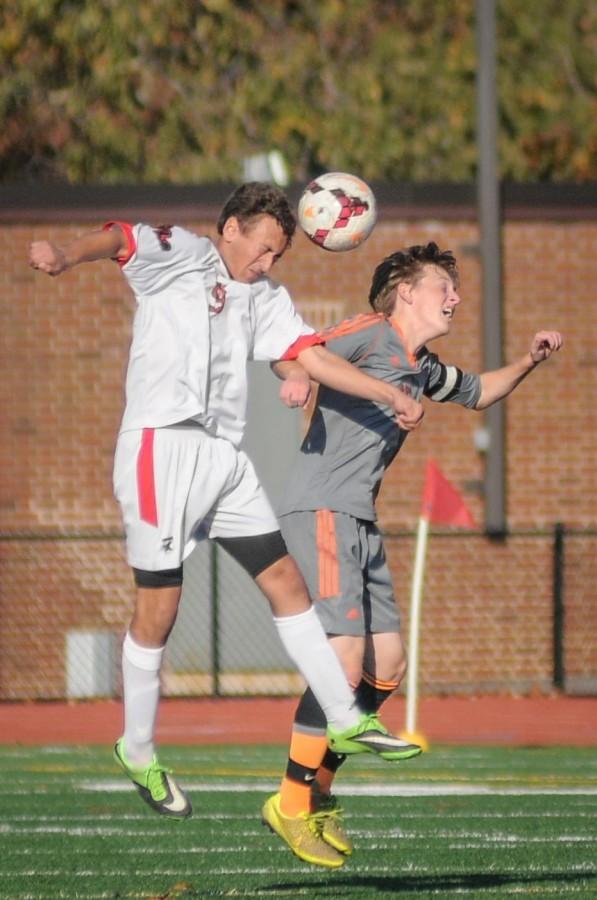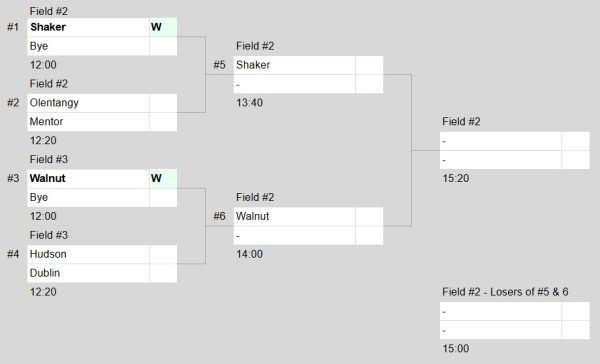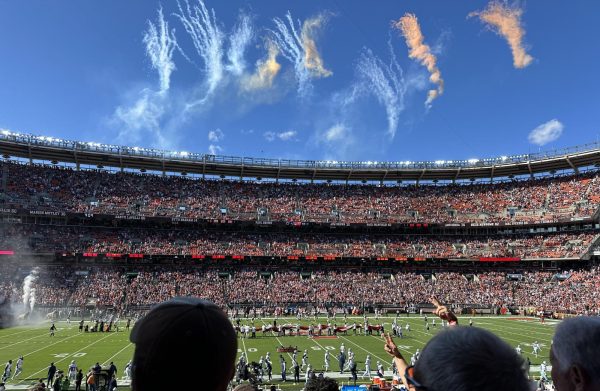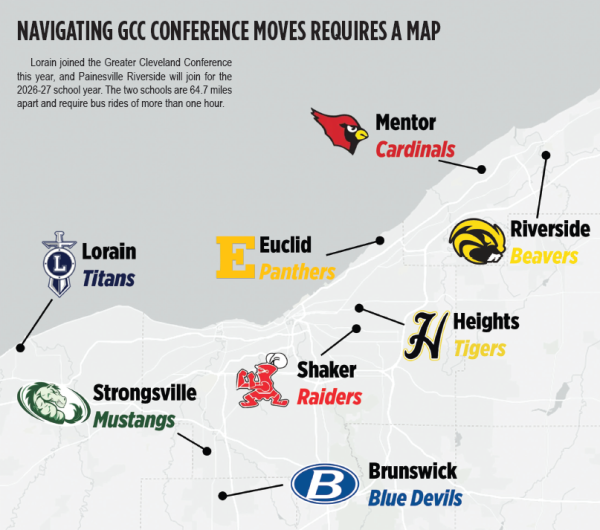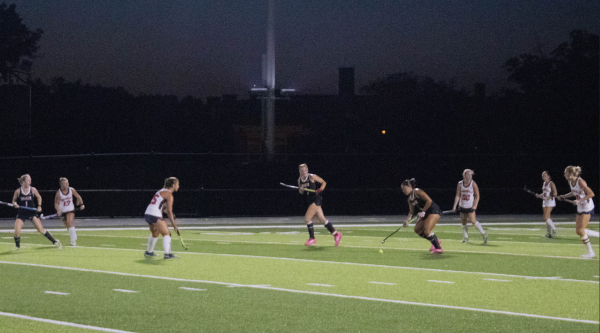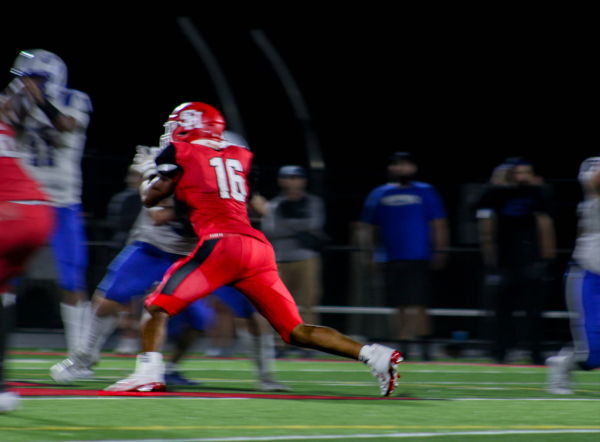Concussions Sideline Student Athletes
Senior Evan Pascarella heads the ball during a game against Eastlake North, Oct. 25. This move is an example of many that make the player prone to concussions and other injuries.
“I could tell you where I was, but I would start crying and laughing for no reason. I threw up on the way to the hospital and all I could remember was rounding third and then nothing,” sophomore Molly Amolsch said, describing her softball-induced concussion.
Freshman Sophie Greff suffered four concussions from basketball and soccer injuries. “Everything was hard, and life was really boring,” she said. “You can’t concentrate, and you have to take things really slow. Everyday life changed until you were clear.”
In recent years the laws, regulations and education to protect high school athletes from concussions have been strengthened. Five years ago, most of the regulations created to reduce the risk of concussions were not in place.
Concussions are traumatic brain injuries caused by a hit to, or violent shaking of, the head. The movement causes the brain to move around and hit the skull, damaging brain cells.
“It’s a scary thing. It’s not like a laceration, where you know it will heal cleanly if you keep it bandaged and clean,” school nurse Paula Damm said. “It’s your brain and it’s so important for everything.”
According to the National Federation of State High School Associations, 140,000 high school athletes sustain concussions each year, the majority resulting from high-contact sports such as football, hockey and soccer.
Headaches or head “pressure,” nausea, dizziness, confusion and problems concentrating are all symptoms of concussions.
Amolsch recalled her experience after she collided with another player and her head hit the ground. “You can’t tell immediately if you have a concussion, and the ER doesn’t diagnose you so that they aren’t liable, so I had to see a specialist, and all the tests took hours,” she said.
To test for concussions, many schools require the imPact test for all student athletes. Before the season, students are given a baseline test; if a concussion is suspected, the student is given the test again and the results are compared.
“ImPact testing on the computer measures response to certain questions and is a baseline,” said Athletic Director Don Readance. “If a player is concussed, they see if there is a change in responsiveness, and a verbal assessment can determine if a player has a concussion.”
If a player is hit in the head during a game, officials, trainers or coaches can remove the athlete from the game and have them tested. Should an athlete give any sign of a concussion, parents are notified and the athlete is encouraged to visit a doctor.
“More safeguards are in place now. I believe it’s the safest it’s been to play contact sports because of the increase of awareness,” Readance said.
Return to Play, a protocol implemented by the Ohio High School Athletic Association gives specific instructions for coaches and trainers about what to do with a concussed player and how to ease the athlete back into playing.
The OHSAA also introduced regulations limiting full contact for football players during practices to further ensure high school athlete’s safety.
“There must be a release from a doctor and build-up to certain things in practice to make sure we don’t send anybody back too soon on the field,” Readance said.
The testing and protocols aren’t foolproof. Concussion may develop and symptoms emerge days after the impact.
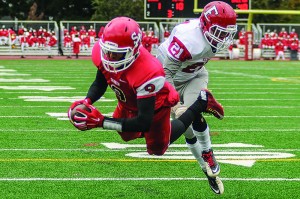
- Will McKnight
96 percent of deceased NFL players had signs of a degenerative brain disease, according to studies from The Department of Veterans Affairs and Boston University’s Chronic Traumatic Encephalopathy Center. Since the study, sports impact on the brain has been a subject of national debate.
“Be informed. Be educated. If you see changes in a classmate that weren’t there before, such as struggling in school when they had not struggled before, having a harder time focusing, more sleepy than normal, or just not acting themselves, those are all potential signs of a concussion,” Dr. Richard Figler, co-director of the Cleveland Clinic Concussion Center, said in an email interview.
Concussions affect not only students’ athletic careers, but also all other aspects of life.
“People are generally surprised with the impairment people initially have. People can’t do homework, can’t watch TV, can’t look at a computer — a lot of ‘can’ts,’ and this causes kids to stress out because how would you ever catch up?” Damm said.
Recovery periods range from a week to months and in extreme cases the district provides students with a 504 plan to assist them with their academics.
“If a concussion becomes too huge and students need a lot of accommodations, the teachers, myself and guidance counselors have a meeting for more formal accommodations called a 504 plan,” Damm said. “Often diabetics or somebody who needs unrestricted access to the nurse has one. We don’t typically do this at the beginning, only if the concussion doesn’t go away or a student needs more long-term help.”
“Treatment is individualized so it is important for teachers to be flexible with the student,” said Dr. Christopher Tangen, a sports medicine physician at University Hospitals in a phone interview.
Amolsch struggled for nine months with the consequences of her concussion. “It made the school year really rough, I missed 54 days of school and probably left early or came late from doctor appointments another 50 days,” she said. “My grades slipped, and it soon got to the point to where I didn’t even see the point in doing any work when I was just going to miss another day and fall behind again.”
Amolsch received tutoring to keep up with school work. “I had a specialist who I took homework to, but she worked on me with things that you teach little kids, like how to read,” she said.
“Reading hurt. It took very long to do my homework, and I would always get so dizzy and nauseous from doing work,” added Amolsch. “It was really discouraging; I just wanted to sleep all day and to lay down because that was the only way to make the headaches go away.”
The OHSAA has been pushing for coaches, trainers and nurses to become more educated about concussions.However, Amolsch said teachers need to be informed as well.
“There needs to be more education about concussions. I thought it was just a bump in the head, but teachers need to know how to deal with them,” said Amolsch. “After so much time had passed, they didn’t really understand I’d still have headaches all day. It was hard to explain to people I was still hurt.”
“I think [concussions are] difficult to avoid,” said Tangen. “In the medical world, we are trying to find ways to prevent concussions. A lot of things would have to change, and contact sports would have to be completely different. What we think can be helpful now is cognitive rest — basically resting the brain — and to stay out of school until the symptoms get better.”

